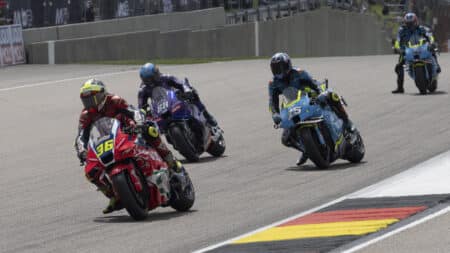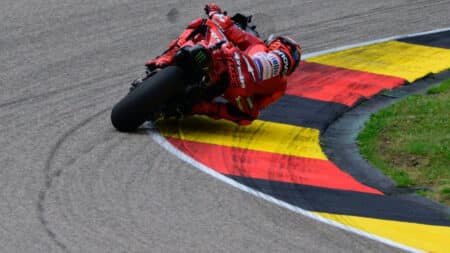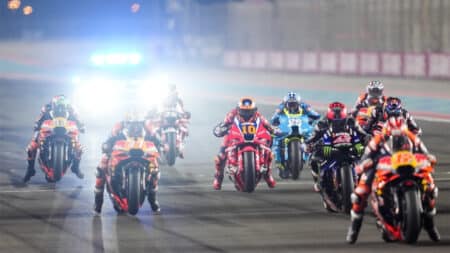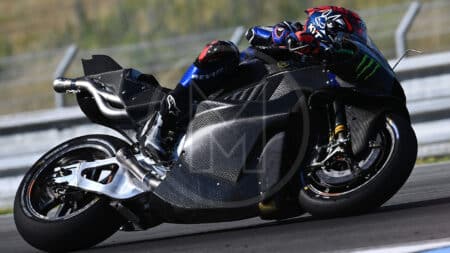Here are a few philosophical questions for you. Can motorcycle racing ever be too safe? Or how safe/dangerous should MotoGP be? Should MotoGP return to the Isle of Man TT and damn the consequences, or should Dorna take advantage of the trillions of dollars available from Middle Eastern oil nations keen to establish mind-bogglingly ostentatious racetracks in their kingdoms, with thousands of metres of sandy runoff at every corner?

The only reason I ask is in reaction to a couple of frankly bizarre recent moves to ‘improve’ MotoGP circuit safety. The first was at Catalunya’s Turn 10, the low-speed left-hander at the end of the back straight that claims many victims because it’s downhill, it’s bumpy, it’s made slippery by F1 cars and (possibly most importantly) it’s the last real overtaking opportunity of the lap; i.e. it’s now or never.
At last year’s Catalan GP there were 28 crashes at Turn 10, making it the most crashed-at corner of the year, but zero injuries of any consequence. This year there were 21 falls at the same corner and once again everyone who fell there was fit to race.

Nonetheless, riders were presented with a ‘safer’ alternative Turn 10, as used by F1 cars, to evaluate during June’s post-Catalan GP tests. The prime concern is a lack of run-off in case of a brake failure or collision, because the gravel trap can’t be expanded due to lack of space.
So what’s going on: has some eager health and safety and official wheedled his/her way into Dorna, determined to usher in an era where crashing and the possibility of getting hurt are impossibilities?
It was the same again when we arrived at the Sachsenring, where safety officials had designed a re-profiled Turn 11, the daunting high-speed right-hander that catches out many riders. Last year there were 10 crashes at Turn 11, this year there were eight, of a weekend total of 64. Cal Crutchlow fell victim to the corner last year and again this year. He took a major beating on both occasions, but was able to race.
Unlike Catalunya’s Turn 10, Sachsenring’s Turn 11 is fast: nudging 130mph. It’s also scary, because it’s the first right-hander after a unique run of seven lefts, so the right side of the tyres haven’t touched the track for around 30 seconds, so they may be too cool to grip properly. Significantly, most crashes there happen in cool morning sessions.
Low tyre temperature is a frightening thing for a rider. To makes matters worse, Turn 11 is blind, with negative camber and comes so soon after the Turn 10 left that the tyres aren’t fully loaded onto the track. A health and safety official would call it an accident waiting to happen.
All these reasons and more are why it’s my favourite corner of the entire MotoGP season. As soon as I arrive at the Sachsenring I hot-foot it to Turn 11 and stand against the Armco, agog.
I don’t go there to see people crash; I go there to see them walk the line, because walking the line is what motorcycle racing is all about. If I want to see the glories of human physique and technique, I’ll watch tennis. But I want more than that, I want to see human beings having the mother of all battles in their minds as they try to walk that line between going fast enough to win and fast enough to crash. And what I really want to see is the most talented riders using their skills to walk beyond that line and still get away with it. To me, that’s what bike racing is all about.
As far as I’m concerned, racing isn’t about riders skating around second-gear corners. And that’s my greatest fear, that one day we’ll end up with circuits composed entirely of constant radius second- and third-gear corners, carefully designed so that anyone can get around them safely. The day that happens will be the day I go home and start gardening.

It’s a head-scratching conundrum: I don’t want bike racing to be too dangerous, but if it does become too safe, then the sport changes entirely. I suppose I’m with rough, tough American writer Barnaby Conrad, who said: “Only bullfighting, mountain climbing and auto racing are sports, the rest are merely games”. (But I disagree on the bullfighting.)
Even Wayne Rainey, who broke his back at an innocuous corner at Misano in 1993, agrees. “You’ve still got to have corners that are challenging to the riders and normally those are the difficult ones,” he says. “Are you going to make it easy for everybody? Because that’s not right; I think they should just leave them as they are.”
Many riders discussed Turn 11 during the weekend, explaining why it’s so risky. Cold tyres and lack of load are the main issue.
“If it was always hot and sunny, Turn 11 wouldn’t be a problem,” said Crutchlow, who had another big off there on Saturday afternoon. “I don’t want to see one of the great corners spoiled, but after we saw everyone crash there last year we can’t do nothing about it.”

One answer from those post-2013 discussions was a re-profiled Turn 11, which several riders tested on Thursday. I stood there with my jaw on the floor as sheet metal kerbing was moved into place, to somewhat sharpen the corner. Then Bradley Smith, Andrea Iannone and Stefan Bradl rode a few laps, speeding past the kerb at 120mph. What, I wondered, would happen if one of them fell and tangled with the metal kerb, its edges standing several inches proud of the asphalt? Unlikely, of course, but the very next morning – when the metal kerb had been removed – Smith crashed right there! So much for health and safety.
Also, the re-profiling did nothing to alter the primary problem: that the right side of the tyres are too cool for Turn 11. Hence the other answer was a dual-compound front slick from Bridgestone, but the tyres didn’t arrive in time for this year’s race because they were stuck in customs.
Perhaps Dunlop’s more squidgy Moto2 tyres work better in this situation – the fastest Moto2 riders take T11 at 124mph, the fastest MotoGP men do it at 127mph. But the corner claims twice as many MotoGP victims.

Moto3 rider Jack Miller also watched the Turn 11 test and was typically forthright in his views. “It’s f***ing stupid,” he said. “They’re going to ruin a great corner. It’s the same for everyone – just don’t crash there!”
Miller’s views are shared by many riders, because most riders get their biggest buzz from fast, challenging corners. True, it was the riders who suggested improving safety at these corners, but once presented with the ‘improvements’, most rejected them and want to carry on as normal.
Best of all, though, was Sachsenring winner Marc Márquez (his fifth consecutive win at the track), who confirmed my theory that the best riders use their talent and intelligence to a) make a dangerous corner safer and b) get through there faster than anywhere else.

“Through Turn 11 you need to be smoother than at other corners,” he said. “But the big thing for me is to go slightly slower through Turn 10, in order to be safer in Turn 11. So I sacrifice one for the other.”
In other words, he’s slower through 10, so he puts himself to the left of the track to give him a wider entry line into Turn 11, so he can get the tyres fully loaded before he’s using any real lean angle. That’s how to separate the men from the boys. Which is what it’s all about, surely?











